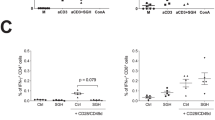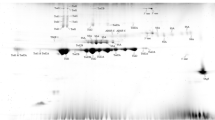Abstract
The saliva of the sand fly Lutzomyia longipalpis, a major vector of Leishmania, exhibits pharmacological and immunomodulatory activities that may facilitate entry and establishment of parasites into the vertebrate host. Salivary gland components of the sand fly are, therefore, potential candidates in the development of a vaccine against human leishmaniasis. With the objective of identifying sand fly saliva proteins that could be used to immunise animals against canine visceral leishmaniasis, we have evaluated anti-saliva antibody reactivity using serum samples collected from dogs naturally infected with Leishmania chagasi. Two proteins with molecular weights of 28.6 and 47.3 kDa were recognised by dog antibodies in Western blot assays. Protein bands were excised from an SDS-PAGE gel and the sequences determined by mass spectrometry. The proteins were identified as LuLo-D7 and Lulo YELLOW, respectively. The significance of these findings in the context of the development of multi-component vaccination experiments is discussed.



Similar content being viewed by others
References
Albert S, Klaudiny J, Simuth J (1999) Molecular characterization of MRJP3, highly polymorphic protein of honeybee (Apis mellifera) royal jelly. Insect Biochem Mol Biol 29:427–434
Altschul SF, Madden TL, Schaffer AA, Zhang J, Zhang Z, Miller W, Lipman DJ (1997) Gapped BLAST and PSI-BLAST: a new generation of protein database search programs. Nucleic Acids Res 25:3389–3402
Alvar J, Cañavate C, Molina R, Moreno J, Nieto J (2004) Canine leishmaniasis. Adv Parasitol 57:1–88
Arcà B, Lombardo F, Lanfrancotti A, Spanos L, Veneri M, Louis C, Coluzzi M (2002) A cluster of four D7-related genes is expressed in the salivary glands of the African malaria vector Anopheles gambiae. Insect Mol Biol 1:47–55
Cavalcante RR, Pereira MH, Gontijo NF (2003) Anti-complement activity in the saliva of phlebotomine sand flies and other haematophagous insects. Parasitology 127:87–93
Charlab R, Valenzuela JG, Rowton ED, Ribeiro JM (1999) Toward an understanding of the biochemical and pharmacological complexity of the saliva of a hematophagous sandfly Lutzomyia longipalpis. Proc Natl Acad Sci 96:15155–15160
Gillespie KM, Szeto CC, Betin VM, Mathieson PW (2000) Role of beta1 and beta2 subunits of the interleukin-12 receptor in determining T helper 1/T helper 2 responses in vivo in the rat. Immunology 99:109–112
Gomes RB, Brodskyn C, de Oliveira CI, Costa J, Miranda JC, Caldas A, Valenzuela JG, Barral-Netto M, Barral A (2002) Seroconversion against Lutzomyia longipalpis saliva concurrent with the development of anti-Leishmania chagasi delayed-type hypersensitivity. J Infect Dis 186:1530–1534
Graham LA, Tang W, Baust JG, Liou YC, Reid TS, Davies PL (2001) Characterization and cloning of a Tenebrio molitor hemolymph protein with sequence similarity to insect odorant-binding proteins. Insect Biochem Mol Biol 31:691–702
Kamhawi S, Ramalho-Ortigao M, Pham VM, Kumar S, Lawyer PG, Turco SJ, Barillas-Mury C, Sacks DL, Valenzuela JG (2004) A role for insect galectins in parasite survival. Cell 119:329–341
Kubar J, Fragaki K (2005) Recombinant DNA-derived Leishmania proteins: from the laboratory to the field. Lancet Infect Dis 5:107–114
Laison R, Shaw JJ (1987) Evolution, classification and geographical distribution. In: Peters W, Killick-Dendrick R. The leishmaniasis in biology and medicine. Academic, London, 1–20
Lanzaro GC, Ostrovska K, Herrero MV, Lawyer PG, Warburg A (1993) Lutzomyia longipalpis is a species complex: genetic divergence and inter-specific hybrid sterility among three populations. Am J Trop Med Hyg 48:839–847
Lerner EA, Shoemaker CB (1992) Maxadilan. Cloning and functional expression of the gene encoding this potent vasodilator peptide. J Biol Chem 267:1062–1066
Mannervik M (1999) Target genes of homeodomain proteins. Bioessays 4:267–270
Mohebali M, Khamesipour A, Mobedi I, Zarei Z, Hashemi-Fesharki R (2004) Double-blind randomized efficacy field trial of alum precipitated autoclaved Leishmania major vaccine mixed with BCG against canine visceral leishmaniasis in Meshkin-Shahr district, I.R. Iran. Vaccine 22:4097–4100
Molina R, Amela C, Nieto J, San-Andres M, Gonzalez F, Castillo JA, Lucientes J, Alvar J (1994) Infectivity of dogs naturally infected with Leishmania infantum to colonized Phlebotomus perniciosus. Trans R Soc Trop Med Hyg 88:491–493
Morris RV, Shoemaker CB, David JR, Lanzaro GC, Titus RG (2001) Sandfly maxadilan exacerbates infection with Leishmania major and vaccinating against it protects against L. major infection. J Immunol 167:5226–5230
Palatnik-de-Sousa CB, dos Santos WR, Franca-Silva JC, da Costa RT, Reis AB, Palatnik M, Mayrink W, Genaro O (2001) Impact of canine control on the epidemiology of canine and human visceral leishmaniasis in Brazil. Am J Trop Med Hyg 65:510–517
Reis AB, Martins-Filho OA, Teixeira-Carvalho A, Carvalho MG, Mayrink W, Franca-Silva JC, Giunchetti RC, Genaro O, Correa-Oliveira R (2006) Parasite density and impaired biochemical/hematological status are associated with severe clinical aspects of canine visceral leishmaniasis. Res Vet Sci 81:68–75
Rogers KA, Titus RG (2003) Immunomodulatory effects of maxadilan and Phlebotomus papatasi sandfly salivary gland lysates on human primary in vitro immune responses Parasite Immunol 25:127–134
Rogers ME, Ilg T, Nikolaev AV, Ferguson MA, Bates PA (2004) Transmission of cutaneous leishmaniasis by sand flies is enhanced by regurgitation of fPPG, Nature 430:463–467
Sacks D, Kamhawi S (2001) Molecular aspects of parasite–vector and vector–host interactions in leishmaniasis. Annu Rev Microbiol 55:453–483
Sambrook J, Russel DW (2001) Molecular cloning: a laboratory manual, 3rd edn, vol 3. Cold Spring Harbor Laboratory Press, Cold Spring Harbor
Shevchenko A, Wilm M, Vorm O, Mann M (1996) Mass spectrometric sequencing of proteins from silver-stained polyacrylamide gels. Anal Chem 68:850–858
Tesh RB (1995) Control of zoonotic visceral leishmaniasis: is it time to change strategies? Am J Trop Med Hyg 52:287–292
Thiakaki M, Rohousova I, Volfova V, Volf P, Chang KP, Soteriadou K (2005) Sandfly specificity of saliva-mediated protective immunity in Leishmania amazonensis-BALB/c mouse model. Microbes Infect 7:760–766
Valenzuela JG, Belkaid Y, Garfield MK, Mendez S, Kamhawi S, Rowton ED, Sacks DL, Ribeiro JM (2001) Toward a defined anti-Leishmania vaccine targeting vector antigens: characterization of a protective salivary protein. J Exp Med 194:331–342
Valenzuela JG, Garfield M, Rowton ED, Pham VM (2004) Identification of the most abundant secreted proteins from the salivary glands of the sand fly Lutzomyia longipalpis, vector of Leishmania chagasi. J Exp Biol 207:3717–3729
Vieira JB, Coelho GE (1998) Visceral leishmaniasis or kala-azar: the epidemiological and control aspects. Rev Soc Bras Med Trop 31:85–92
World Health Organisation (2000) Leishmania/HIV co-infection South-Western Europe 1990–1998: retrospective analysis of 965 cases. WHO/LEISH/2000, Geneva (http://whqlibdoc.who.int/hq/2000/WHO_LEISH_2000.42.pdf)
Acknowledgements
We are grateful to Leila Alves Campus for her technical assistance. This work was supported by the CNPq/BR/Grant: 541521124/98-0, FAPEMIG/BR/Grants: CBS 2222/97 (ABR) and CBB 174/02 (DB); PDTIS (Fiocruz) and FAPERJ (Rede Proteômica do Rio de Janeiro). DB was a recipient of CNPq and FAPESP fellowships. The experiments described in this study were carried out in full accordance with all pertinent laws and codes of practice applicable in Brazil.
Author information
Authors and Affiliations
Corresponding author
Rights and permissions
About this article
Cite this article
Bahia, D., Gontijo, N.F., León, I.R. et al. Antibodies from dogs with canine visceral leishmaniasis recognise two proteins from the saliva of Lutzomyia longipalpis . Parasitol Res 100, 449–454 (2007). https://doi.org/10.1007/s00436-006-0307-8
Received:
Accepted:
Published:
Issue Date:
DOI: https://doi.org/10.1007/s00436-006-0307-8




